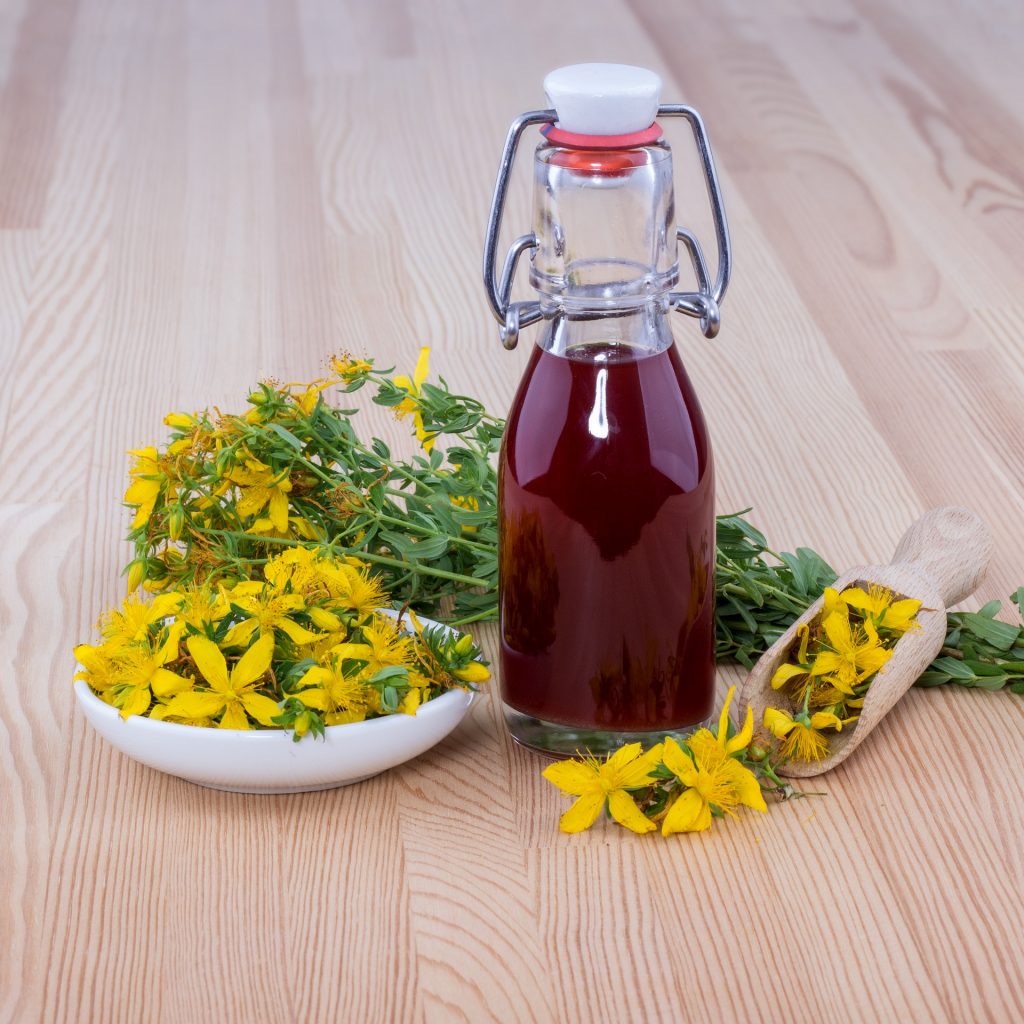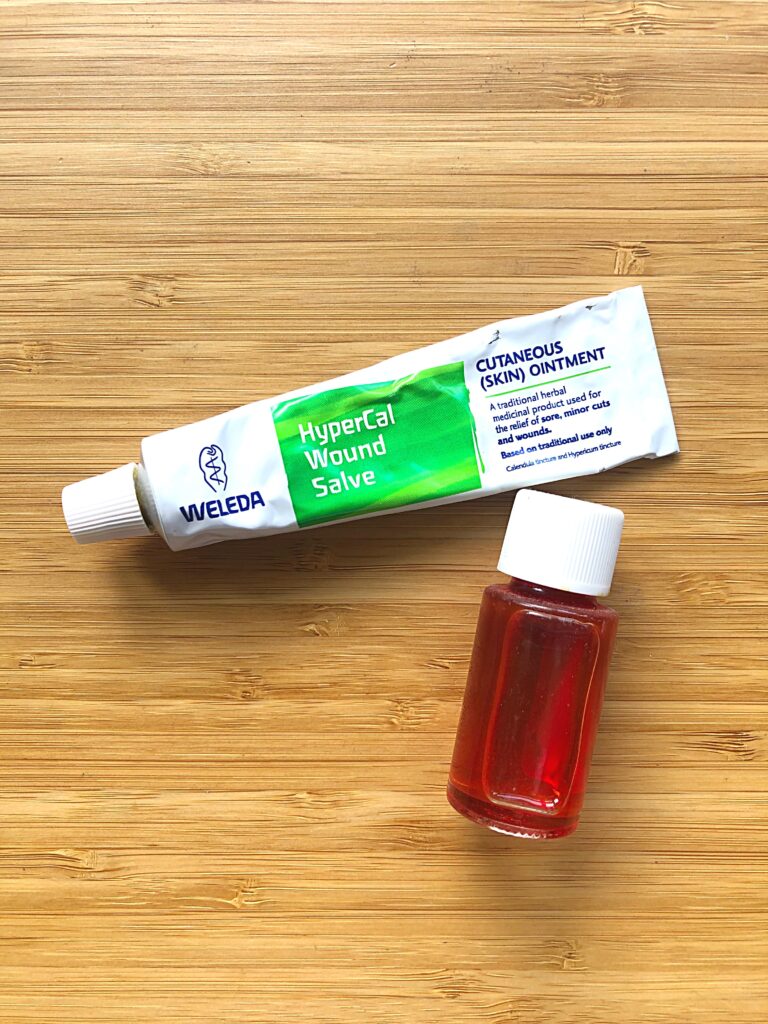The golden saviour
In the week of the summer solstice, I usually begin to look around fields and street borders, to try and spot if there is some St. John’s wort that can be harvested by the 24th of June, in order to prepare my annual batch of ruby red oil. I use it for many purposes during the year, from healing burns and small cuts, to calming the skin after sun exposure or to be added in cold creams and balms. If sunshine could be bottled, it would be like St’ John’s wort oil.
As of lately I have discovered as well the property for which it is mostly famous nowadays in modern phytotherapy: it’s mild but steady antidepressant activity. And I’ve been positively impressed by the effect of the integration of this herb for mood disorders, which made me only love it even more.
A helpful ally
St. John’s wort, or Hypericum perforatum, is a plant from the Hypericaceae family, is a herbaceous perennial plant. Common St John’s wort has been used in herbalism for centuries. Hypericum perforatum is a common species and is grown commercially for use in herbalism, traditional medicine, and phytotherapy: both hypericin and hyperforin, chemical compounds found in St. John’s wort flowering tops, are under study for their potential antibiotic properties.
St John’s wort derives its name from the fact that it commonly flowers, blossoms, and is harvested at the time of the summer solstice in late June, around St John’s Feast Day on 24 June. The herb would be hung on house and stall doors on St John’s Feast Day to ward off evil spirits and to safeguard against harm and sickness to man and live-stock.

Modern Uses
St. John’s wort has been long been acknowledged as a wound herb, and oil obtained by the infusion of flowers has been used in the last centuries for wound healing, used on the battlefield and appreciated for its pain-relieving action.
Modern science has luckily studied this plant thoroughly and backed the traditional knowledge with scientific researches.
Used externally
The infused oil is used for wound healing, thanks to its mild but constant pain killing property, as mentioned above, and for its powerful anti-inflammatory activity. For these same reasons is very helpful to be used in case of small burns, cuts and sunburn, or after sun exposure anyway. It helps the skin repair itself and has antiseptic properties too, in addition to the antibacterial and antimycotic ones.
Used internally
Studies have shown that extracts of St. John’s wort are superior to a placebo in the treatment of mild to moderate depression. And it has been discovered it has a similar effect to some of the standard prescription antidepressant drugs but with fewer side effects.
It is also beneficial for nervousness, anxiety and seasonal affective disorder, and PMS (pre-menstrual syndrome), and menopausal anxiety.
It’s still being studied for its possible antiviral and antibiotic effects at the moment, always thanks to the action of Hypericin and Pseudohypericin.
To treat mild depression and mood disorders you can take St. John’s wort tablets, and you might be lucky enough to find the mother tincture as well, which is more easily absorbed by our organism, and easily adjusted in terms of dosage. The drops work really well associated with valeriana officinalis drops, and again have been proven to be better tolerated giving less side effects than normal drugs. but is not very easy to find.
My personal experience
On a serious note, I have used this plant to help myself get out of a depression, just a few months ago, and I felt indeed the benefit of using it. But I used it as a part of a bigger strategy, that included many other focused actions. I have not relied on this plant only. I had some therapy in the past and used nutrition and meditation and planned exercise, together with a good introspection, to be able to feel better. And it took months.
Based on my experience, it much depends on how severe your symptoms are: for a seasonal mood change, a PMS, or mild mood depression, can work really well in synergy with other healthy lifestyle choices. But If you have severe depressive symptoms, please call your GP or contact the Samaritans through this link, search for help! You do not want to risk that the plant action might be too mild or take too long to have effect, if you are suffering from a severe depression, do not underestimate your symptoms and get help!
How To make St. John’s wort oil
Traditionally, fresh flowering tops are steeped in olive oil using the sun infusion method.

Ingredients
Sterilised, wide mouthed, clear glass jar
Freshly picked flowers
Olive oil
Muslin lined sieve
Sterilised jar or bottle for storage
Sunshine
Preparation
Half fill your wide mouthed, sterilised jar with herbs and then cover it with oil, shaking slightly to eliminate any air bubble, and ensure all the herbs are evenly covered. Then cover with a clean muslin as a lid, and leave it in a sunny place, being careful to turn every day for 4 weeks, until the essence of the plant has transformed the oil, and it is a pure and intense ruby colour.
After the infusion period, strain through a muslin lined sieve into a clean, sterilised jar or bottle, preferably dark to maintain the oil properties longer. Seal, label and date it.
As many vegetable oils, you’ll know when you can’t use it anymore as its scent will turn rancid, but having the Hypericum oil such a strong scent to start with, try to use it within a year.

Contraindications
Use of St. John’s wort internally has interactions with many other drugs, like the many oral contraceptive, warfarin, so it’s worth paying attentions, and check carefully the leaflet of the drugs you are assuming to ensure there is no risk, if you are in doubt consult your GP before taking it.
Taken internally it can cause sensitivity to the sun, and it is best not using it if you are pregnant or breastfeeding without medical supervision.
St. John’s wort oil is one of the main products in my natural first aid kit, have a look at the article to find out more. If you do not have time to prepare the oil yourself, a well formulated ready made solution is the Weleda Hypercal Ointment , go shop on my Weleda webpage.
Have you ever tried St. John’s wort herbal remedies? Let me know in the comments!
Sources and bibliography:
Enrica Campanini “Phytotherapy and Medicinal plants dictionary” by TecnicheNuove
Vicky Chown & Kim Walker “The handmade apothecary – Healing herbal remedies”
https://en.wikipedia.org/wiki/Hypericum_perforatum
*Cover Image and oil image credit to Pixabay